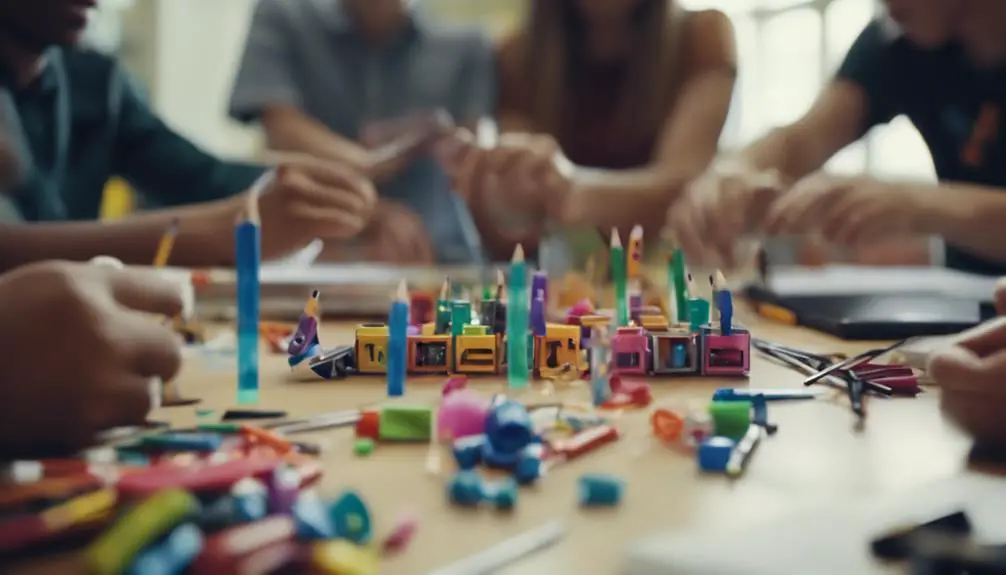I was surprised to discover that interactive learning in the classroom can boost student engagement by up to 85%.
This approach offers a wide range of benefits that go beyond traditional methods, impacting how students learn and work together.
It is essential in today’s educational landscape, to cater to the diverse needs of learners.
The advantages of interactive learning are truly remarkable, influencing not only how students absorb information but also how they collaborate and problem-solve.
This method fosters a more engaging and effective learning environment, preparing students for success in their academic and professional endeavors.
Why Interactive Learning in the Classroom
Increases Student Engagement
Interactive learning is essential for keeping students engaged in the learning process. When students actively participate in interactive activities, they’re more attentive, and enthusiastic, and absorb information more effectively. This high level of engagement not only benefits individual students but also contributes to a dynamic classroom environment where everyone is involved and contributing.
One of the key advantages of interactive learning is its ability to cater to different learning styles, making the learning experience more inclusive and effective. By incorporating visual, auditory, and kinesthetic elements, interactive learning ensures that each student can engage with the material in a way that resonates with them. This approach not only enhances comprehension but also fosters a sense of inclusivity and belonging within the classroom.
Furthermore, interactive learning plays a crucial role in shaping classroom dynamics by promoting collaboration and teamwork. Through active participation, students not only improve their learning experience but also develop valuable communication and interpersonal skills. Ultimately, interactive learning creates a vibrant and stimulating learning environment where everyone has the opportunity to engage, learn, and grow together.
Accommodates Multiple Learning Styles
Every student is unique, and interactive learning embraces that by combining visual, auditory, and kinesthetic elements to suit different learners.
Interactive learning caters to students with different learning styles by incorporating visual, auditory, and kinesthetic elements. This personalized approach ensures that each student can engage with the material in a way that suits them best.
Here’s how interactive learning accommodates diverse learning styles:
- Tailored assessments: Interactive learning allows for customized assessments to pinpoint individual strengths and areas for improvement. This personalized feedback helps educators adjust their teaching methods to support each student effectively.
- Multisensory activities: By integrating visual, auditory, and kinesthetic activities, interactive learning provides a comprehensive learning experience that appeals to various learning styles. This approach enhances understanding and retention by enabling students to interact with the material in multiple ways.
- Personalized instruction: Recognizing students’ unique learning preferences and paces, interactive learning promotes personalized instruction. Educators can adapt their teaching strategies to meet the individual needs of each student, fostering a supportive environment for academic success.
Enhances Collaboration
Collaborating on interactive projects helps students enhance their teamwork skills and learn from diverse perspectives. Teamwork is essential for success, and collaborative projects create a sense of community and shared accomplishment. By working together, students not only improve their ability to collaborate effectively but also develop crucial communication and leadership abilities.
In the realm of education, teamwork dynamics play a crucial role in shaping the learning experience. Collaborating on interactive projects allows individuals to leverage their unique strengths while benefiting from their peers’ knowledge. This peer learning environment encourages knowledge sharing, idea exchange, and gaining insights from different viewpoints, ultimately fostering academic growth and a spirit of cooperation among students.
Participating in group activities enriches the educational journey and prepares students for real-world scenarios where collaboration is key. Through interactive projects, students deepen their understanding of the subject matter and form lasting bonds with their classmates. This collaborative approach not only enhances the learning process but also cultivates a sense of camaraderie and shared achievement, laying a solid groundwork for future success.
Better Retention of Information
The hands-on experience means students are more likely to remember the material. It’s like the difference between reading about riding a bike and actually pedaling one.
Hands-on activities significantly improve students’ ability to remember information compared to passive learning methods. Actively engaging in learning enhances memory retention for several reasons. Firstly, hands-on activities accommodate various learning styles, such as visual, auditory, and kinesthetic, ensuring that students can connect with the material in a way that suits them best. This tailored approach increases the likelihood of retaining information effectively.
Secondly, participating in hands-on tasks prompts students to think critically and sharpen their problem-solving skills. This active involvement fosters a profound comprehension of the subject matter, leading to better memory retention over time. By actively grappling with the material, students not only learn but also internalize the information for long-term recall.
Moreover, the immediate feedback loop provided by hands-on experiences is invaluable. Students can promptly adjust their approach based on real-time feedback, reinforcing their learning and enhancing memory retention. This instant correction mechanism ensures that students grasp concepts thoroughly and remember them accurately.
Fosters Critical Thinking and Problem-Solving
Interactive learning often involves problem-based learning, which pushes students to think critically and solve complex problems.
Interactive learning promotes critical thinking and problem-solving skills through problem-based learning. This approach challenges students to think analytically and address complex issues effectively. By immersing students in real-world scenarios, interactive learning encourages them to develop creative solutions and make informed decisions. Through hands-on activities and group discussions, students enhance their ability to think critically and approach challenges with innovative problem-solving strategies.
Engaging in interactive learning transforms students from passive recipients of information to active participants in their educational journey. By tackling intricate problems, students cultivate analytical skills crucial for success in today’s ever-evolving world. The emphasis on critical thinking and problem-solving equips students with valuable tools to navigate diverse situations confidently and creatively. Moreover, interactive learning fosters collaboration and teamwork, emphasizing the significance of diverse perspectives in generating innovative solutions.
Assists with Real-Time Feedback
Teachers can provide immediate feedback through technology, helping students understand what they’ve got right and where they need improvement.
Leveraging technology to provide instant feedback to students is an effective way to enhance learning. This approach offers immediate gratification by giving students prompt responses to their work, reinforcing positive actions, and correcting mistakes right away.
It supports continuous improvement as students can quickly adjust their learning strategies based on the feedback received. Timely interventions are also possible, allowing teachers to address challenges as soon as they arise, and preventing misconceptions from taking root.
Technology enables educators to deliver personalized feedback tailored to each student’s unique needs, creating a supportive learning environment that fosters growth. By offering instant corrections, students can promptly rectify errors, leading to a better understanding of the material.
This interactive feedback loop empowers students to take ownership of their learning journey, promoting self-awareness and accountability. Not only does this approach boost academic performance, but it also cultivates essential skills for lifelong learning.
Prepares Students for the Digital Age
Integrating tech-savvy interactive tools in classrooms is crucial for equipping students with essential tech skills vital for navigating the modern digital landscape. This emphasis on tech literacy ensures that students are well-prepared for success in a digitally-driven world. By actively engaging with interactive tools, students gain practical experience that enhances their digital readiness and deepens their grasp of contemporary educational practices.
In today’s fast-paced technological landscape, possessing tech literacy is a non-negotiable skill. Students must adeptly navigate digital platforms, comprehend software applications, and harness online resources. Through the integration of interactive tools in the learning process, educators empower students to cultivate the skills necessary to thrive and adapt in the digital age.
Furthermore, these interactive experiences not only foster tech proficiency but also nurture crucial problem-solving abilities and critical thinking skills. Students learn to collaborate, innovate, and communicate effectively through digital mediums, preparing them for the dynamic requirements of the modern workforce.
In essence, incorporating tech-forward interactive tools in the classroom transcends traditional teaching methods. It equips students with the competencies essential for excelling in an increasingly digital world, ensuring they’re well-equipped for the challenges and opportunities that lie ahead.
Boosts Motivation Through Games and Simulations
Incorporating interactive games and simulations in the classroom boosts student motivation by making learning enjoyable and engaging. Game-based learning enhances understanding of complex concepts, while interactive simulations increase engagement by allowing students to actively interact with the material. These fun activities not only motivate students but also create a positive learning environment.
Here are three key reasons why games and simulations can significantly impact student engagement and motivation:
- Enhanced Learning Retention: Immersing students in virtual reality and classroom games maximizes educational benefits as interactive experiences help students retain information better.
- Increased Student Engagement: Interactive simulations capture students’ attention, making learning more enjoyable and promoting active participation in the educational process.
- Elevated Motivation Levels: Fun learning activities through games and simulations keep students motivated, eager to participate, and enthusiastic about learning, fostering a genuine interest in education.
Tailors Learning to Individual Pace
Interactive platforms in the classroom adjust to each student’s learning pace, ensuring that all individuals can progress without falling behind. This personalized approach revolutionizes the way we tailor learning experiences to meet the unique needs of every student. By allowing students to advance at a rate that aligns with their comprehension, these platforms enable customized learning paths.
One of the key benefits of interactive learning is its adaptive nature, which moves away from a one-size-fits-all model toward individualized education. Through personalized learning opportunities, interactive platforms create a supportive atmosphere where each student can excel. This customization and personalization empower students to take ownership of their education, fostering independence and confidence as they navigate their learning journey.
As an educator, observing the progress and growth of each student through adaptive education is exceptionally gratifying. The flexibility offered by interactive platforms not only enhances learning outcomes but also nurtures a sense of achievement and self-assurance in students. By embracing tailored learning experiences, we can truly unlock the full potential of every learner.
Encourages Self-Directed Learning
Students have the tools to take charge of their learning journey, fostering independence and self-confidence.
Shifting from a one-size-fits-all approach, students now have the opportunity to take control of their learning journey, promoting independence and self-confidence. This move towards self-directed learning offers numerous advantages, empowering students to be proactive in their education.
Here are three key benefits of this student-centered approach:
- Empowerment and Autonomy: Allowing students to choose how and what they learn fosters a sense of ownership over their education. This autonomy boosts their confidence and encourages a proactive approach to learning.
- Flexible Progress and Independent Study: Students can advance at their own pace, delving deeper into topics of interest or spending more time on challenging concepts. This personalized method caters to individual learning preferences and enhances comprehension.
- Personalized Learning and Student Accountability: Embracing self-directed learning places the responsibility on students to engage actively with the material. This tailored approach not only enhances understanding but also cultivates essential skills like time management and self-discipline.
Enables Immediate Application of Knowledge
Through interactive learning, students can apply what they learn right away, reinforcing the material.
Interactive learning seamlessly bridges the gap between theory and practice, which is often a challenge in traditional learning environments. For example, in a science class, conducting experiments allows me to witness scientific principles in action, making complex ideas easier to comprehend. Similarly, in a language class, engaging in real-time conversations with classmates hones my communication skills more effectively than rote memorization.
The hands-on experience gained through immediate application cements the concepts in my memory, making them easier to recall when necessary. This active approach not only enhances my learning journey but also boosts my confidence in applying what I’ve learned. By reinforcing knowledge in real-time, interactive learning equips me to absorb and retain information more efficiently, setting me up for success in academia and beyond.
Saves Costs and Time
Digital materials and online simulations offer schools a cost-effective and time-saving solution for educational resources. These tools provide affordable alternatives to traditional physical materials, helping schools reduce expenses.
Educators can access a wide range of resources quickly, saving time that would otherwise be spent creating or sourcing physical materials for lessons. Online simulations enable students to engage in interactive learning experiences that simulate real-world scenarios, enhancing their understanding without the need for extensive physical resources.
By implementing digital materials and online simulations in educational settings, schools can eliminate the constant need to replenish physical materials, saving costs in the long run.
These resources also streamline lesson preparation by providing readily available materials for educators. Moreover, the immersive nature of online simulations offers students a more engaging learning experience, ultimately enhancing the effectiveness of classroom instruction.
Flexible Learning Environments
Interactive learning is not bound by the four walls of a classroom; it can happen anywhere, making education accessible and flexible.
Interactive learning has evolved with digital tools and online resources, allowing education to extend beyond traditional classrooms. This shift creates flexible learning environments that offer various benefits, such as engaging students in different settings.
Outdoor classrooms immerse students in hands-on experiences in natural surroundings, fostering a deeper connection to the environment. Virtual field trips transport students to distant places and historical sites, expanding their perspectives without leaving the classroom.
Mobile learning enables continuous access to educational materials, supporting learning on the go. Remote and blended learning models further enhance flexibility, empowering students to personalize their learning and educators to cater to diverse learning styles effectively.
Embracing flexible learning environments makes education more accessible, engaging, and tailored to individual needs.
Conclusion
In essence, interactive learning acts as a catalyst that sparks students’ curiosity and engagement. It illuminates their minds, guiding them through a labyrinth of knowledge and experiences.
Through interactive learning, students not only acquire knowledge but also soar to new heights, delving into uncharted territories and broadening their worldviews.
This approach fosters a journey of exploration where each step leads to a more vibrant and engaging educational experience.













